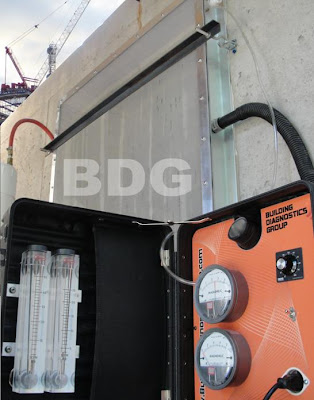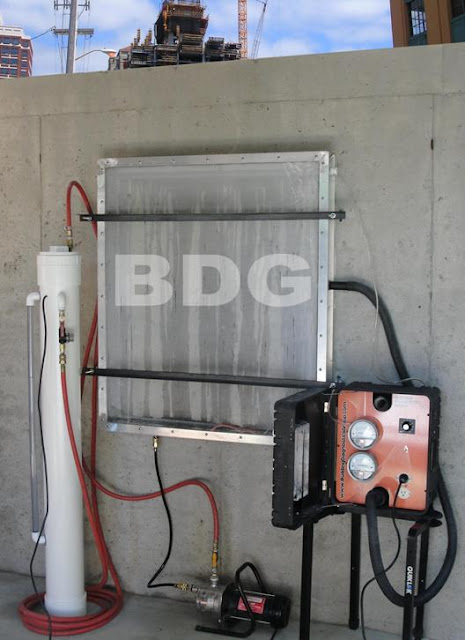About the ASTM C1601
The test chamber is a rectangular chamber with a minimum area of 12 sf. This chamber is attached to the wall system using mechanical fasteners and sealant to prevent loss of water and maintain proper air pressure. Water is delivered via a single line of spray nozzles placed 1 inch apart across the top of the test chamber. This creates a sheet flow condition (continuous film of water) during testing. Water is pumped from the reservoir at a pre-specified flow rate (typically 3.4 gal/sf/h) while at the same time static pressure is applied and maintained at 10lbs/sf. These parameters simulate conditions equivalent to 62.5 mph winds and 5 ½ inches of rain per hour. Alternate testing conditions may be used based on local climatological data. The test duration is 4 hours after 30 minutes of pre-conditioning to calibrate flow rates and stabilize the system.
Common uses:
- Repair comparisons – determine the effectiveness of repairs or new coatings
- Determine water penetration rate through defective wall systems
- Assess existing wall systems
- Litigation support
- Evaluate material compatibility
- Mock-up testing for conceptual wall systems
- Quality control testing (new construction)
Typical testing conditions:
- Air pressure: 10 psf
- Water application: 3.4 gal/ft2/h
- Pre-conditioning: 30 minutes
- Test duration: 4 hours
Variations - test may be altered based on local considerations:
- Standard test method – 10 psf (62.5 mph wind)
- Alternate test – 5 psf (45 mph wind)
- Alternate test – No wind
Project example:
Building Diagnostics Group, Inc. (BDG) was retained to determine the effectiveness of a penetrating sealer used on a cast-in-place concrete masonry parking structure. The architect wanted to compare the untreated walls to walls treated with the sealer.
To mount the test chamber, we applied three types of perimeter sealant along the face of the test chamber; a firm caulk cord, soft butyl glazing tape, and finally a heavy bead of Dow Corning® 795 to the inside edge. Once the sealants are in place we secured the chamber to the wall and allowed it to cure overnight.
The following day we connected the reservoir, blower, and drain pump to the chamber. We then began the 30 minutes of pre-conditioning. This allowed us to check the entire system for leaks and adjust the pressure and flow to the testing specifications. It is extremely important to maintain a consistent “sheet flow” across the entire test specimen. After 30 minutes, we began the testing by documenting the water level in the reservoir. During the 4 hours we documented changes in flow patterns, water flow rates, air pressure fluctuations, and monitored the water level. At the end of the testing we determined the amount of water absorbed through the wall system by measuring the remaining water in the reservoir, plus the amount of water added, and subtracted our beginning level. In this case, our bare wall absorbed an average of 0.74 gal/h for a total of 2.958 U.S. gallons.
The ASTM C1601 offers no guidance to acceptable levels of water loss but many still refer to the Monk. C. B., Jr. Adaptions and Additions to ASTM Test Method E514 (Water Permeance of Masonry) for Field Conditions chart below.
Water Intrusion Rate Gal/Hr
|
Rating
|
< 0.375
|
Excellent
|
0.375 – 0.5
|
Average
|
0.5 – 1.0
|
Questionable
|
> 1.0
|
Poor
|
Interpreting water loss data for masonry walls (Monk, 1982)
Based on the above table, the untreated wall was “questionable”. After the sealer was applied, we returned to the same test area and performed the same testing procedures. This time the wall absorbed about 0.261 gal/h for a total of 1.046 U.S. gallons. The sealer significantly reduced the amount of water absorption.
Building Diagnostics Group, Inc. (BDG) is committed to our clients by continuously investing in the development of high-quality testing equipment. Our equipment is calibrated to each specific testing standard for accurate results. Additionally, our field consultants are properly trained and knowledgeable of all testing standards. Our new heavy-duty ASTM C1601 chamber system took over a year to perfect, its design saves hours of set-up time and is consistent in providing reliable data.
If you are looking for a reputable second or third party testing company to perform accurate professional testing, provide concise reports, and help you through the entire process, contact BDG today. We provide testing services throughout the United States from our headquarters located in Atlanta, GA.
For more information please visit our water infiltration webpage HERE.






